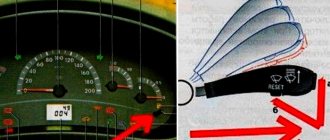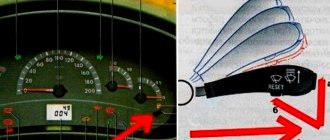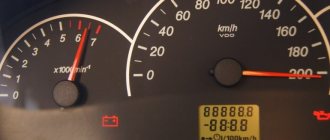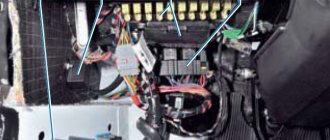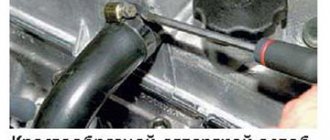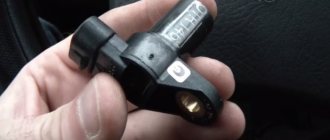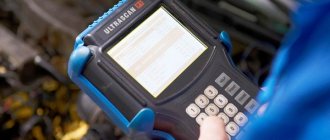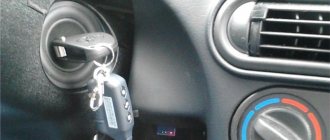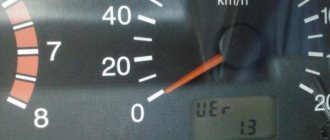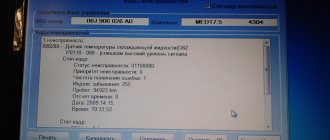Secondary parameters of motor operation
Engine idle speed test results
- Throttle Position (THR) value. This parameter is determined by a special sensor. If the throttle position value shows an error and malfunction, the car owner may notice some jerks with “dips” while driving. An increase in the number of idle revolutions will also indicate the presence of a problem. This parameter should be checked with the ignition on, but it is not recommended to start the engine itself. When you gradually press the gas pedal, the readings on the monitor should smoothly increase to 90%. It should be taken into account that it is impossible to achieve 100% - this is predetermined by the manufacturers. The sensor is considered operational if the procedure was successful. Idle speed should show 0%.
- Crankshaft and its rotation frequency (FREQ). The diagnostic figure will be displayed on the screen by a special crankshaft position sensor. The malfunction is easy to notice even without diagnostic equipment, because the engine simply will not start. Indicators from the sensor normally vary in the range from 800 to 840 rpm.
- Limit of uneven crankshaft rotation (LUMS_W). This figure should not exceed 4 rpm. Otherwise, you can be sure that there are misfires in the cylinders. With such a malfunction, it’s time to check the spark plugs and high voltage wires.
- Ignition timing (UOZ). Data from several sensors are combined into one indicator and calculated by the electronic control unit. The value varies from 6 to 15.
This is the way to check engine operation using a diagnostic connector and special equipment. Digital code records are formed from symbolic symbols of car faults. They can be seen on the dashboard dial.
Lada Kalina does not start when cold
- If the crankshaft rotates slowly, the battery may be discharged or the engine oil may be frozen.
- The vehicle's fuel system is faulty. The water in the ramp may have frozen.
- The coolant temperature sensor (DTOZH) of the engine management system is faulty.
- Fuel injectors are leaking.
- Low compression in cylinders.
- The engine control system is faulty. Run diagnostics.
Let us remind you that regular vehicle maintenance will help eliminate engine starting problems.
How to see if there are errors in Kalina's work
What are the error codes for Lada Priora 8 and 16 valves?
Launching self-diagnosis of the Lada Kalina is carried out according to the same principles as on other cars of the VAZ family. The process has only minor differences:
- Turn the ignition key to position 1, then press the daily mileage reset button (located in the lower right corner). After this, you will see the movement of all the arrows on the panel.
- Then press the button located on the wiper control handle. After this, symbols will appear on the on-board computer display.
- Press again to display the ECU software version.
- You need to press the handle button again. This will help display a list of errors that the computer detected during self-diagnosis.
After this, all you have to do is evaluate the information and conduct more detailed diagnostics of the car.
If the Lada Granta has error P0504
Error codes on the instrument panel of the VAZ-2112: decoding
Error P0504 stands for “brake pedal sensor misalignment.”
The design of the operation is as follows: A double brake light switch is installed, one circuit is activated when the pedal is pressed, the other when the pedal is released. The pedal press signal goes to the brake lights themselves and to the ECU, and the pedal release signal goes only to the ECU. If the ECU “suspects” that there is something wrong with the brake light lamps (mismatch), it issues error P0504.
To eliminate the error, check the contacts and adjustment of the sensor on the brake pedal. The gap between the limit switch cap and its body when the pedal is in its initial state should be 0.5 mm. If the problem is not solved, replace the sensor with a new one. Craftsmen solve the problem in the following way: wires from a normally closed pair are connected through the normally closed contacts of a conventional relay. The relay is controlled, respectively, from the normally open contacts of the sensor. However, we recommend that you contact an authorized dealer under warranty to resolve this issue.
Let us remind you that the website has a survey on choosing an on-board computer.
Keywords: on-board computer Lada Granta | Lada Granta engine | Lada Kalina engine | on-board computer Lada Kalina | ECM Lada Granta | ECM Lada Kalina
35
6
Found an error? Select it and press Ctrl+Enter..
What is the essence of this system
"Toyota": error codes and decoding
Kalina's automatic fault diagnosis system includes several devices. The display displays information that is processed by all devices. To prevent car owners from having to independently service their cars, manufacturers do not try to talk about the location of the devices and their decoding. This is explained quite simply: if a car owner who does not have the proper experience decides to repair the Lada Kalina on his own and without the advice of specialists, seeing error 0441 on the display, then he can only worsen the technical condition of his “four-wheeled friend.”
Since the Lada Kalina does not have an on-board computer, the owner will only be able to visually familiarize himself with the code number, and he will have to guess the location of the breakdown on his own. In order to avoid mistakes when repairing your car, experts recommend knowing each code by heart in order to promptly eliminate any type of malfunction.
Check the fuel filler cap
Many drivers, in most cases, when the “check engine” indication appears, will think about serious problems in the car’s engine, but will not even think to check the tightness of the fuel system, which may be compromised due to a defect or an insufficiently tightened fuel tank cap. This is a very common reason for the appearance of the “Check” engine icon.
Reason for the error: Leakage of the fuel system due to the passage of air through the filler cap of the fuel tank will increase the vehicle's fuel consumption, to which the vehicle's diagnostic system will generate an engine error by turning on the "Check engine" indication on the vehicle's instrument panel.
What needs to be done: If, when the “Check” indication appears, your car has not lost power, and there are no audible signs of engine damage (engine knocking, humming, creaking, etc.), then first check the gas tank for leaks. Your gas cap may be cracked or not tightened enough. If the cap was not tightened enough, then after tightening it all the way, continue driving the car for a while to see if the engine error disappears. To prevent a check engine light from appearing for this reason, check your fuel filler cap regularly. Remember that the cover must be replaced with a new one periodically!
Children's diseases Lada Kalina (Lada Kalina)
Another strong quality of mine is the heater. It warms up the interior quickly, which is great because no one in this family ever has time, especially on a winter morning. The maximum window blowing mode, when the air conditioner is turned on along with the heater, helps a lot (especially in the absence of a heated windshield). The heating of the mirrors and rear window also works quickly - before you have time to look back, the mirrors are already clean... So, in general, my winter goes as it should for a normal Russian car: not without problems, but also without any serious troubles, quite safely.
But they still stuffed the dog into me! I won’t say that it was particularly pleasant, but both the people and, it seems, even the dog, were satisfied. Before me, they had a hatchback, and this infernal animal (actually, I’m not sure it’s a dog, more like some kind of fossil woolly crocodile) was pushed in there with a little tension. In my trunk, along with the dog, I can also fit a sled, so now I regularly give my owners walks through the forest, as they call this improvised bobsled with the finish line in a snowdrift... In general, spring is coming! And the first maintenance, and great travels, and new discoveries... I hope only pleasant ones.
Trouble
• Minor assembly flaws like the glove compartment lid and heated glass, which the dealer doesn’t really want to change;
• the multimedia complex will be changed;
• the middle interior air deflectors are stuck in the middle position;
• the seat has a short cushion and insufficient lumbar support - the driver gets tired on a long journey;
• “velvety” upholstery of chairs collects dust and feathers from down jackets as much as possible.
Troubleshooting
The Lada Kalina has a central control unit for the injection engine and vehicle electrical system. Problems that arise during the operation of electronic and electrical systems are recorded by the unit in the form of errors and stored in memory. If there are such problems, the orange Check Engine light on the panel lights up. Some errors can be displayed on the screen installed on the instrument cluster and deciphered.
Code analysis allows you to accurately determine the incorrectly operating element and repair or replace this unit. You can check for problems more deeply and thoroughly by connecting a special scanner to the diagnostic connector. The diagnostics and list of errors are the same on a 16-valve car and on a car with a simpler 8-valve engine.
Step-by-step self-diagnosis
Checking for errors in the ECU and displaying their numbers on the dashboard is called self-diagnosis. This procedure is not complicated and can be easily done independently.
In this case, the owner of a Lada Kalina 1118 station wagon or sedan must perform the following actions:
- Get behind the wheel of a Lada Kalina car and press the daily mileage reset button on the instrument cluster (Reset).
- Turn on the ignition while holding the button pressed.
- The instrument cluster will switch to test mode, during which the full backlight will turn on, all indicator lamps will turn on, and the device arrows will begin to move smoothly in both directions along the scale.
- Using the button on the right lever of the steering column switch, you can sequentially change menu items, including self-diagnosis of devices, software version (firmware, inscription like Uer x. x) and error codes in the unit’s memory.
- It is necessary to look at the codes recorded in the ECM and determine their meaning.
- To exit the self-diagnosis mode, you need to wait about 30 seconds without performing any actions.
Kalina steering column switch button
The modernized Kalina 2 has a slightly different instrument panel design. The procedure for displaying errors is similar; codes appear in the top line of the display as a three-digit number. Below the indicator line, information about the vehicle's serial number is displayed (looks like a six-digit number).
What to do?
Let's look at ways to eliminate the main faults that cause the check on Kalina to light up (8 and 16 valves) in the same sequence as the causes of the problem.
A broken oxygen sensor requires replacement. If this malfunction is ignored for a long time, the catalyst will become a further victim. As a result, subsequent repairs will cost a tidy sum.
In case of insufficient tightness of the gas tank closure, the cap is checked for cracks and tightness. If the check goes out after a certain distance after intensive screwing, then the problem has been resolved. It should be remembered that the tank cap needs to be changed from time to time.
If the catalyst is faulty, fuel consumption increases significantly and engine thrust decreases. Definitely, in this case the check will remind you of this. To fix the problem, you will need to replace the catalyst. It is better to entrust this expensive procedure to experienced craftsmen, since delay is fraught with more serious problems with the need to invest significant funds.
Timely replacement of spark plugs will prevent the Check Engine sensor from lighting up due to contamination or wear. Experts advise changing these elements after 25,000-30,000 km. mileage High-voltage wires require similar attention, the failure of which can also cause the activation of the check indicator.
On Kalina 8 and 16 valves, replacing the mass fuel flow sensor does not pose a serious problem. Although you can drive with a faulty element for quite a long time, fuel consumption and the blinking of the check mark will remind you of the need to install a new part. This procedure will not take much time and will not require significant funds. Timely replacement of the air filter continues the life of the sensor in question.
Old spark plugs and high voltage wires
If the engine light comes on, you need to check the spark plugs. They perform an important function; they participate in the ignition of fuel in the engine. If the spark plugs are faulty, then the spark is not supplied to the gasoline mixture. If there is no spark, the car may not start or the engine may not operate properly. Incorrect operation of the spark plugs leads to small tremors.
Car service specialists recommend replacing spark plugs after 25-30 thousand kilometers, especially if the car is old. However, the service life of spark plugs is directly influenced by the quality of the fuel and driving style. Faulty spark plugs are usually very noticeable.
- The car starts with difficulty.
- Fuel consumption increases.
- The catalyst fails.
Viburnum weak points | Automotive portal SC-Finec
Viburnum weak points
The Volzhsky plant has been producing the Lada Kalina model for several years now, and although enough time has passed, the car has become a finished product from that raw material. However, there were, are and will be some shortcomings. Lada Kalina can present you with surprises already in the first thousand kilometers, or you can drive it for 40,000 and no problems will emerge. But still, average statistical data says that Kalina does have weak points. And if we are talking about two years of operation, then minor illnesses of Kalina will include real breakdowns and serious malfunctions. But don’t worry, most of these cases are fixed under warranty.
Electrics The horn refuses to work, especially in the rain. Electric windows often fail to work. The relay of the forced engine cooling fan “sticks”. Headlights The bulbs in the headlights often burn. Poor contacts of the side light bulbs in the headlights. In the cold, the headlight glass may crack for no apparent reason. Interior After a while time after purchasing a Lada Kalina, various sounds begin to appear in the car’s interior. Good sound insulation and a bulkhead of the interior will help get rid of them. Parallel in the seats is of poor quality. Creaking of door and window seals. Gearbox Howling of clutch gears in the gearbox. It is recommended to replace the factory oil in the box. The wire for protecting the reverse gear from being switched on randomly is worn out, as a result of which reverse gear does not engage. Poor quality clutch disc often requires replacement at 25-30 thousand km. Chassis Weak rear shock absorbers. Weak front suspension. Brake system How and in the Lada Granta, defective brake pads (damage the brake disc). Cooling In the cooling system of the Lada Kalina engine, the weak points are the sensor, pipes and pump. After two years of operation, the heater begins to leak and if this problem is not corrected in time, the ECU may also flood. Leakage Coolant from the expansion tank through one of the clamps of the system pipes. Body The rear window washer tube bursts in the cold (needs to be replaced with a silicone one). Several rear window heating threads may not work from the factory. The muffler is of poor quality, it will rot after two years. Poorly adjusted The locks, especially the rear doors, are difficult to open after a while.
Category: Useful tips Tags: Body, Interior, Brake system, Lights, Chassis, Electrics
sc-finec.ru
Diagnosis of errors
When you begin to notice something unusual in the behavior of your car, or there are obvious problems in its operation, then it certainly makes sense to have it diagnosed. Naturally, the OBD-II diagnostic connector will show errors most efficiently and accurately, however, not everyone has sockets to control this connector and has to use the standard one.
In order to enter self-diagnosis mode, you must:
- Turn off the ignition.
- Click on the daily vehicle mileage button.
- Then, continuing to hold it, turn the key in the lock.
- Thanks to this, all available indicators will light up, and the dial indicators will go into self-test mode and show data from zero to maximum.
- When this happens, use the button located on the steering column switch and use it to switch the data on the instrument panel.
- To read the fault codes, we need the last one - the third screen. Unambiguous error codes will be displayed there.
Displaying the error code on the third screen of the bookmaker. The photo shows error 4 (faulty coolant temperature sensor).
Error codes (decoding)
These are the most common error codes that can appear if there is a malfunction on the Lada Kalina.
Code Explanation 2 Excess of voltage in the vehicle's on-board network. 3 Malfunction of the gasoline level sensor in the fuel tank
Possible circuit break. 4 When this code appears, the car owner needs to pay attention to the operation of the antifreeze temperature sensor. There is also a possibility of a circuit break. 5 There is a problem with the outside temperature sensor. 6 The control unit has detected engine overheating
It is recommended to deal with this problem before further operation of the car. 7 Emergency lubricant pressure in the internal combustion engine is reported. 8 If you see this code on the dashboard, then you need to check the functionality of the brake system. The on-board computer recorded an error or breakdown in its operation. 9 The on-board computer reports that the battery charge is too low. It is recommended to perform a more thorough check of the battery. E An error has been reported in the data packet stored in the EEPROM.
Checking the system using special equipment
If the system is checked through a diagnostic block using OBD-II, then the code combination will consist of four characters, preceded by a letter at the very beginning.
P - indicates a problem with the engine or transmission. C - displayed when an error occurs in the “running”. B - when such a letter designation appears, you should pay attention to the serviceability of the central locking system, airbags, and power windows.
The second digit means:
- 0 – common code for OBD-II;
- 1 – number of the car manufacturer;
- 2 – number of the car manufacturer;
- 3 – reserve code.
The third character refers directly to the type of failure:
- 1 – malfunction in the air supply system and fuel system.
- 2 – similar to code “1”.
- 3 – failures and malfunctions in the ignition system.
- 4 – auxiliary control.
- 5 – malfunctions during idle operation.
- 6 – malfunction of the ECU or its circuit.
- 7 and 8 – malfunction in the transmission.
Malfunctions and ways to eliminate them
1. When trying to start the engine, the crankshaft does not rotate
1. The terminals on the battery terminals are not tightened enough or are oxidized.
2. The battery is low or faulty.
3. The starter electrical circuit is faulty (“Starter”),
4. Starter drive parts are faulty.
5. The starter traction relay is faulty.
6. The electric motor (armature, brush assembly windings) of the starter is faulty.
7. The ignition switch (lock) is faulty (see “Ignition switch (lock) - check”)
8. The flywheel ring gear is damaged or worn.
2. The crankshaft rotates, but the engine does not start
1. There is no fuel in the tank (fill the tank with fuel).
2. The crankshaft does not rotate fast enough to start the engine due to the low battery charge.
3. The terminals on the battery terminals are not tightened enough or are oxidized.
4. Leakage of parts of the power system, faulty fuel module or fuel pressure regulator.
5. The timing belt is broken.
6. The engine control system is faulty.
7. The electrical circuit of the ignition coils is faulty.
8. The crankshaft position sensor or its electrical circuit is faulty.
3. Difficulty starting a cold engine
1. The battery is discharged or the electrolyte level is insufficient.
2. The power system is faulty.
3. The engine management system coolant temperature sensor is faulty.
4. Fuel injectors are leaking.
5. The engine control system is faulty.
4. It is difficult to start a warm engine
1. The air filter is clogged.
2. The power system is faulty.
3. The terminals on the battery terminals are not tightened enough or oxidized, the connection between the battery and ground is poor.
4. The engine management system coolant temperature sensor is faulty.
5. The starter makes a lot of noise (grinding)
1. The flywheel ring gear is damaged or worn.
2. The starter mounting bolts are loose.
6. Engine starts but stops immediately
1. Ignition coil electrical connections are loose or damaged.
2. Insufficient pressure in the engine power supply system.
3. The connections of the intake tract parts are leaky.
4. The engine control system is faulty.
7. Oil stains appear under the engine
1. The oil pan gasket is leaking or the drain plug is not tightened tightly.
2. The seal of the emergency oil pressure sensor is broken.
3. The cylinder head cover seal is leaking.
4. Crankshaft seals are worn or damaged.
8. Engine speed at idle either decreases or increases
1. The connections of the vacuum hoses are leaking (check the tightness of the fittings).
2. The air filter is clogged.
3. Insufficient fuel pressure in the engine power supply system.
4. The cylinder head gasket is damaged.
5. Wear of the timing belt and/or tension roller.
6. Worn camshaft cams.
9. Misfire at idle
1. The spark plugs are faulty or the gap between the electrodes is incorrectly set.
2. High voltage wires are faulty.
3. The connections of the vacuum hoses are leaking (check the tightness of the fittings).
4. The ignition coil is faulty.
5. Insufficient compression in the engine cylinders.
6. Fuel injectors are faulty.
10. Misfire when the engine is running under load (while the car is moving)
1. The fuel filter and/or the engine power supply lines are clogged.
2. Fuel injectors are faulty.
3. The spark plugs are faulty or the gap between the electrodes is incorrectly set.
4. The insulation of high-voltage wires is damaged.
5. The engine control system is faulty.
6. Insufficient compression in the engine cylinders.
7. Leakage (burnout) of the gas distribution mechanism valves.
8. The ignition system is faulty.
9. The connections of the vacuum hoses are not tight (check the tightness of the fittings).
eleven . The engine does not develop full power
1. Worn camshaft cams.
2. Leakage (burnout) of the gas distribution mechanism valves.
3. Incorrect valve timing setting.
4; The ignition system is faulty.
5. The engine power supply system is faulty.
6. The air filter is clogged.
7. Wedging of the working cylinders of the brake mechanisms.
8. The clutch slips.
9. The fuel filter and/or the engine power supply lines are clogged.
10. The engine control system is faulty.
11. Insufficient compression in the engine cylinders.
12. The exhaust system is faulty.
12. When the engine is running, the emergency oil pressure warning lamp lights up
1. Insufficient oil level.
2. Idle speed is below normal.
3. Short circuit in the “sensor - control lamp” circuit (see electrical diagrams).
4. The sensor for the emergency oil pressure warning lamp is faulty.
5. Worn crankshaft main bearings and/or oil pump.
13. Glow ignition (the engine continues to run for some time after the ignition is turned off)
1. High idle speed.
2. Engine overheating.
3. Carbon deposits on valves and combustion chambers.
14. Increased fuel consumption
1. The air filter is clogged.
2. The engine control system is faulty.
3. Fuel injectors are faulty.
4. Insufficient air pressure in tires.
15. Fuel leaks and/or gasoline smell
1. Leaking fuel lines.
2. Fuel tank is full (remove excess fuel).
3. Leaking fuel injectors.
16. Engine overheating
1. Insufficient coolant level in the cooling system.
2. Coolant pump malfunction.
3. The radiator of the engine cooling system is clogged.
4. Thermostat is faulty.
5. The electric fan of the engine cooling system is faulty.
6. The valves in the expansion tank cap are faulty (replace the cap).
17. Battery is not charging
1. The alternator drive belt is worn or insufficiently tensioned.
2. Low electrolyte level in the battery.
3. The terminals on the battery terminals are not tightened enough or are oxidized.
4. The generator is faulty.
5. The electrical circuit for charging the battery is faulty (see electrical diagrams).
6. Short circuit in one of the electrical equipment circuits (see electrical diagrams).
7. The battery is faulty.
18. The battery charge indicator lamp does not go out after starting the engine
1. The generator is faulty.
2. The electrical circuit for charging the battery is faulty (see electrical diagrams).
3. The alternator drive belt is worn or insufficiently tensioned.
4. The voltage regulator is faulty.
19. The battery charge indicator lamp does not light up when the ignition is turned on.
The electrical circuit of the generator excitation winding is faulty (see electrical diagrams).
20. The clutch slips (engine speed increases, but the car does not accelerate)
1. Oil getting on the working surfaces of the driven disk.
2. Severe wear, warping and burning of the driven disc linings.
2 1. It is difficult or impossible to change gears
1. The adjustment of the gear shift drive is broken
2. The nuts securing the gear shift lever support have become loose.
3. The gearshift drive rod is deformed.
4. Breakage or wear of the plastic parts of the switching mechanism.
22. Knock (clicking) when turning the car at low speed
1. Wear of external constant velocity joints.
2. Loose front suspension fasteners.
3. Loose steering fasteners.
4. Failure of differential parts.
23. Vibration when driving a car at high speed (over 90 km/h)
1. The balance of the front wheels of the car is impaired.
2. The geometry of tires or wheel rims is damaged due to deformation
3. Wear of constant velocity joints of front wheel drives
24. Moving the car away from straight-line motion
1. Different tire pressures on the front wheels
2. Different degrees of wear on the front tires.
3. Breakage of one of the front suspension springs
4. The adjustment of the front wheel alignment angles is incorrect.
5. Braking of one of the car wheels.
25. Car pulls when braking
1. Different tire pressures on the front wheels
2. One of the brake mechanisms is faulty
3. A hose or pipeline of one of the brake mechanisms is pinched
4. Varying degrees of wear on the brake parts of one of the vehicle axles
26. Uneven tire wear
1. Wheel alignment is incorrect
2. Malfunction of suspension springs
3. One or more wheels are out of balance
4. The vehicle is overloaded or unevenly loaded (unload the vehicle).
27. Excessive steering play
1. Wheel bearing wear
2. Failure of tie rod ends
3. Play in the steering mechanism,
28. Individual headlights or taillights do not turn on
1. Lamp filament burnt out
2. The lamp contact in the socket is oxidized,
3. The wires are damaged or the tips in their connections are oxidized (see electrical diagrams).
29. Individual headlight or taillight bulbs are burning at full intensity
1. Poor contact or damage to the wire connecting the lamp (flashlight) to ground,
2. Dimming the lamp bulb,
30. Car door won't unlock
1. The water in the lock cylinder froze (in winter).
2. The lock cylinder is dirty,
3. The lock cylinder mechanism is damaged,
31. Water enters the interior
1, The door seal is loose or damaged (correct or replace the seal).
2. Doors do not close tightly.
32. Door knocking when the car is moving
1. Wear of axles in door hinges,
2. The door lock screws are not tightened.
33. The door lock does not lock
Jamming of the moving parts of the lock due to dirt or lack of lubrication,
34. The hood lock does not unlock
1, Broken lock drive rod,
35. The tailgate does not stay open
One or both door gas stops are faulty.
Replacing lamps - nuances
Sometimes it is difficult to say which light bulb on model 2114 has lost its functionality. In this case, everything is pulled out and checked with a multimeter. For this:
- set the tester to ohms;
- Press one probe against the side of the base, and the second against the blotch installed at its lower end;
- If the arrow moves, then the filament coil is working.
It is important to remember that the described procedure is not suitable for diode lamps. A different operating principle is used here.
The multimeter must be switched to diode testing mode. The probes are connected in the same way, but during testing they change places - in one direction the current flows without restrictions, and in the other direction it is not allowed to pass at all.
A tester is required for one reason - the light bulb is very small and it is almost impossible to determine the serviceability of the filament purely by eye. The measuring device helps to quickly cope with the task.
Experienced car enthusiasts advise replacing all the lamps at once after disassembling the instrument panel, because they are inexpensive. Otherwise, there is a risk that one or more old ones will soon burn out, and all the work will have to be done again.
When the new lamps are installed, return the instrument panel to the interior, connect the wires to it, but do not fix it. Further:
- turn on the ignition;
- check how the backlight and indicators (handbrake, turn signals, etc.) function.
If everything turns out to be in order, then fasten the panel with screws.
What does error 4 mean?
Fault code 4 indicates that the refrigerant temperature control regulator is not functioning correctly. In most cases, this code lights up on the dashboard if it detects a break in the regulator wiring for 20-30 seconds.
- After analyzing your problem, we turned to many sources on the Internet and consulted with the owners of Lad Kalin. As it turns out, the number 4 often appears on the instrument panel, this can be considered one of the most common errors in these vehicles. Replacing the antifreeze temperature regulator in the cooling system in some cases will help cause the error to disappear. However, according to most potassium growers, in fact, in most cases it does not give a good result.
- If you believe the reviews of car enthusiasts, then such an error, as a rule, appears mainly during cold weather. If there are no signs of breakdowns, then perhaps you have no reason to worry.
- It is likely that over time the vehicle has been used, the sensor itself has oxidized. As a result, a poor contact is formed, which does not allow signal transmission in normal mode. Sometimes this happens after you have washed your car. We recommend that you carry out a visual diagnosis of the regulator - if you notice that the contact has really oxidized, then it needs to be cleaned.
- If there is a continuity, if cleaning the contacts did not help, you need to ring. It is quite possible that the reason for the appearance of the code on the device is a broken wiring or short circuit. In the case of a break, it will be enough to replace the wires or eliminate the cause of the short circuit.
If you have changed the sensor, replaced the wire and cleaned the contact, but the problem still remains, we recommend that you perform more detailed computer diagnostics. In domestic cars, it often happens that if the control unit does not work correctly, errors may appear on the screen that in fact do not exist. To understand this, you need to completely read all the codes from the on-board computer and then draw conclusions.
Engine overheating, problems with the starting system
Cooling system: 1 — expansion tank; 2 — radiator outlet hose; 3 - inlet hose; 4 - radiator; 5 - steam removal hose; b — radiator supply hose; 7 — electric fan; 8 — electric fan casing; 9 — coolant temperature sensor; 10 — coolant temperature indicator sensor; 11 — throttle assembly; 12 — bracket for the coolant pump pipe; 13 — coolant pump; 14 — coolant pump pipe; 15 — heater radiator supply hose; 16 — heater radiator outlet hose; 17 — exhaust pipe; 18 — coolant pump pipe hose; 19 — thermostat housing
However, this method cannot be called universal, so if the engine still does not start, then you need to check the above options. A video on this topic might help. You can recognize that the problem lies in the starter by its unnatural behavior. There are five main faults of this component.
- The starter refuses to turn on. Repairing Kalina in this case comes down to eliminating the breakdown in broken contacts, a break or short circuit in the starter electrical circuits, or a malfunction of the element traction relay.
- When you try to start the starter, you hear characteristic clicks that are repeated many times. In this case, it is necessary to start repairing the Lada with the traction relay, or more precisely, with its winding. The reasons may be a discharged battery or loose contact connections of the starter.
- The starter starts but the armature does not work properly. The main reason is a dead battery. In addition, there may be contact failures or breakdowns of the starter traction relay. The culprit may also be simple contamination of the collector.
- The starter and armature are functioning properly, but the flywheel refuses to operate. As a rule, the cause is a loose starter, broken teeth in the flywheel and lever, as well as the drive buffer spring.
- The starter does not work after starting the engine. The reason lies in a malfunction of the starter freewheel or failure of the traction relay. In this case, it is necessary to immediately stop the engine to prevent its permanent breakdown. The experts in the video will tell you and show you what to do next.
It is very difficult to eliminate the above breakdowns on your own. It is best to contact a specialized service station, where they can quickly find and fix the problem.
In road conditions, you can only check the discharge of the battery using a voltmeter, and also pay attention to whether the contacts in the starter circuit are tightly tightened. The video will help you perform this action correctly.
Return to contents
- Lada Kalina does not start, but the starter turns: the main reasons
Vehicle diagnostics and troubleshooting
If you nevertheless decide to buy a used car, then you should definitely make a diagnosis, paying attention to any Lada error codes that appear on the device display. Information about existing errors will be very useful, be sure to pay special attention to this
To diagnose and find out information, you should contact a car service center if there is no special insert on the used car you are buying.
In fact, such a procedure is a huge list of information that can tell about any possible danger. Usually this is not given importance, but in vain. For example, if a car’s BC states that the airbags are faulty, you definitely need to check this. Correction: what needs to be done? Immediately press the left button and the right one, from this press the on-board computer adjusts the selected parameter.
Then pressing the keys left or right changes the parameters. After pressing simultaneously, you exit from the adjustment. Reset. By pressing the left and right keys simultaneously, the options displayed on the screen will be reset. If everything is done in the “System error” mode, after that the error disappears. If faults actually exist, the error will remain in memory until reset occurs.
If the BC does not turn on, the causes of the problem are:
- there is no electric current in the BC connectors;
- there is no contact in the terminals.
BC cannot diagnose the reasons for this:
- the wire came loose;
- no contact.
BC cannot calculate the speed of the car, the reasons for this problem are:
there is no contact in the connectors.
BC cannot calculate the remainder in the fuel tank, reasons:
devices do not have software compliance.
The BC incorrectly shows how much fuel is left in the tank, the reasons for this are:
- there is no wire in the wiring at the 8th contact and the 9th terminal in the on-board computer;
- The car panel is showing incorrectly.
There is no BC screen backlight, reasons:
I need to make the screen brighter.
https://youtube.com/watch?v=YObsWXcZEJQ
The thermometer shows incorrectly, reasons:
- the wire has broken in the temperature detection sensor;
- incorrect contact with the on-board computer.
No voice accompaniment, reasons:
- speaker is faulty;
- the software has crashed;
- The voice accompaniment is not reproduced (you must press the “up” key and hold it for more than three seconds).
BC writes incorrectly, the program has gone wrong, etc., reasons:
- The on-board computer is not connected or there is no contact with it;
- there is no contact in the connected battery terminal (the contact should be securely fixed).
Initialize the BC:
- previous settings will be reset;
- reset all parameters for the previous ride;
- set the clock to 8 hours 00 minutes;
- The alarm clock should be at zero, its notification is disabled.
Trouble P0441 - Evaporative Emission System - Incorrect Purge Flow
Trouble code P0441 indicates a problem with the evaporative emission system. Other error codes may also appear along with this code.
What does P0441 mean?
Trouble code P0441 indicates that the ECM has detected incorrect purge flow in the evaporative emission control system. If the purge flow is incorrect, the Check Engine Light will illuminate on the vehicle's dashboard. The ECM uses a vacuum switch to determine purge flow.
Causes of error P0441
- Missing or damaged fuel tank cap
- Vacuum switch malfunction
- Damage to the fuel vapor recovery system tubes
- Short circuit or broken wires
- Blockage of the fuel vapor recovery system
- Fuel vapor leak
- Purge valve malfunction
What are the symptoms of a P0441 code?
Typically, when the P0441 error appears, drivers do not notice any signs of its occurrence at all. In rare cases, you may smell fuel inside or outside the vehicle.
How does a mechanic diagnose a P0441 code?
- First, the mechanic will connect the OBD-II scanner to the vehicle's diagnostic port and read all the stored data and error codes.
- He will then clear the error code from the ECM and test drive the vehicle.
- If P0441 appears again, have a mechanic visually inspect the evaporative emission system.
- The mechanic will then check the fuel pressure sensor in the fuel tank for damage.
- He will also check the fuel cap.
- He will then check the operation of the vacuum switch and purge valve.
- If no problem is found, the mechanic will perform a thorough check of the evaporative emission system to check for leaks.
Common errors when diagnosing code P0441
The most common mistake when diagnosing a P0441 code is not following the diagnostic protocol, as well as not performing a smoke leak test.
Also, mechanics often assume that the problem is a damaged fuel cap, but do not perform thorough diagnostics to verify this. It is imperative to check the fuel tank cap for leaks, for example using a vacuum tester.
How serious is P0441?
Error P0441 is not considered very serious. However, it should be noted that if the Check Engine Light comes on, the vehicle will most likely fail an emissions test. Also, when this error appears, drivers may smell fuel.
What repairs can fix the P0441 code?
- Replacing the fuel tank cap
- Repairing a leak in the fuel vapor recovery system
- Repair or replace damaged evaporative emission system components
- Replacing the purge valve
- Vacuum switch replacement
- Repair or replacement of wires
Additional comments for troubleshooting P0441
To properly diagnose the P0441 trouble code, a mechanic will need an advanced OBD-II scanner. It is necessary to check the operation of the vacuum switch and purge valve, as well as to carry out certain tests.
In some cases, a smoke leak test may be necessary to detect a leak in the evaporative emission system. This test can help detect even the smallest fuel vapor leak. The fuel tank shall not be completely empty or completely full during this test.
Need help with error code P0441?
The company - CarChek, offers a service - on-site computer diagnostics; specialists from our company will come to your home or office to diagnose and identify problems with your car. Find out the cost and sign up for on-site computer diagnostics or contact a consultant by phone +7(499)394-47-89
Lada Kalina problems
Domestic cars have bottlenecks, and there are many of them. There is an insufficiently powerful engine, inconvenient controls, and low performance. But all such shortcomings are insignificant if you clearly know why the car is being purchased. For example, the Lada is not suitable for off-road use, but for the city it is simply wonderful. The same is true for the other components.
And yet, if we consider the shortcomings of the car, there is one significant and incorrigible one: the engine. There is nothing particularly bad or good about it. This is a common design for average cars that are in use by the majority of the population. However, the car’s engine tends to break down often.
For example, many Kalina owners complained that the engine stalled at the most unexpected moment, and then simply refused to start. Some were late for work only because the car stubbornly wouldn’t start after being left in the cold overnight. For many, trips in the summer resulted in the engine overheating and, consequently, stopping its operation. There are many examples of such a plan.
But all the above problems can be solved on your own. The main thing is to know how the car works and what steps to take if it breaks down.
Error P0441
Owners of Lada Kalina often note that during the operation of the car, error P0441 appears, indicating that the gasoline vapor purge system is not operating correctly (the air flow differs from the norm). The cause of this malfunction may be:
- inoperative adsorber valve;
- clogging of the air line from the control unit to the air filter;
- air leakage through connecting pipes.
What should not be immediately considered is the line from the gas tank to the adsorber; here, a breakdown does not in any way affect the readings of the computer or diagnostic scanner. Still, most often Evap-Solenoid fails; this is a characteristic “disease” on Kalina.
If the EVAP valve stops functioning normally, it is not at all necessary that the engine will lose power, the fuel pump will fail, and so on. Mainly due to problems with the control gear, exhaust toxicity increases, and the Check Engine on the dashboard periodically lights up. There are car owners who do not pay attention to the diagnostic warning light, continuing to operate the car, but do not experience any great inconvenience. And most often in such a case, gasoline consumption does not exceed the norm, the engine starts normally, and no serious problems occur in the fuel system.
Main disadvantages and weaknesses of LADA Kalina
LADA Kalina has become a truly people's car, but not because of its technical characteristics, quality or convenience. Its popularity is based on its low price. Those who do not have enough money for a foreign car, or those who are afraid to buy a higher-class used car, decide to purchase Kalina.
Car production began in 2004. Since then, the model range has been constantly modernized, the technical components have been improved, and new “chips” have been added for convenience, savings and improvement of various indicators. Depending on the configuration, the 1st generation Kalina was equipped with:
- 8- and 16-valve engines with a volume of 1.4 or 1.6 liters;
- anti-lock brake system;
- two airbags;
- air conditioning;
- electric power steering;
- standard audio system;
- and even an electronic gas pedal.
The first generation of Kalina was produced in three body types: sedan, hatchback and station wagon. In 2008, the Sport version was released. Production ceased completely in 2013, when all conveyors were converted to the second generation.
The disadvantages of the 1st generation LADA Kalina regarding the body, chassis and main components are well known to car owners. There are several known cases when AvtoVAZ recalled produced cars due to identified defects: steering gear housing, engine mounts and others. However, most of the shortcomings fall on car owners. Some put up with them, some try to use ingenuity to correct the developers' shortcomings.
Weaknesses of LADA Kalina 2004–2013 release
- Gear box;
- Brake system;
- Electrical;
- Cooling system;
- Chassis.
Gear box
The Kalina gearbox, both in terms of assembly and the materials used, leaves much to be desired. According to statistics from large service stations, drivers often complain about reverse gear, which refuses to engage due to a damaged protection wire, as well as about problematic second gear.
The clutch disc also fails quite quickly. Many people still complain about extraneous noise from the clutch, even on cars that have just come off the production line. This is usually solved by replacing the gearbox oil with a higher quality one.
Brake system
It is also often necessary to change brake discs, which may develop grooves or uneven wear even after 10 thousand km. The reason for this is most often the pads - poor quality or worn out. Dirt, which is not retained by the anthers, also plays a big role.
Electrics
The problem can strike at the most inopportune moment. The most common complaints are the failure of the horn, power windows, and forced cooling. There are problems with headlights: frequently burning out bulbs or loose wire contacts.
Cooling system
Drivers may be facing repairs due to loose clamps and cracked pipes. This leads to a coolant leak or a leak in the heater radiator. The pump and engine temperature sensors often fail.
Chassis
The Kalina's chassis is still not designed for heavy loads, and after several large potholes it can make itself felt. The shock absorbers, especially the rear ones, do not cope very well with the unevenness of Russian roads.
Disadvantages of LADA Kalina 1st generation
- The main drawback is the build quality. Both the human factor and the low quality of the materials used play a big role;
- Sound insulation is quite poor. Over time, extraneous noise appears. Therefore, it is desirable to treat the entire interior, engine compartment, and trunk;
- Locks are also a common problem, especially on the rear doors. The result is difficult opening, even torn off handles. It is safe to say that they will have to be regulated in the near future;
- Despite the fact that the car was developed for Russia, it does not withstand the cold without problems. There are headlights or washer pipes cracked in the cold. The seals of doors and windows may crack, which leads to disruption of sound insulation and extraneous noise;
- Rust is also the scourge of domestic cars. On Kalina, it first of all affects the muffler, which still burns out quite quickly. Of course, Kalina has gone far ahead of her older brothers. The concern uses galvanized metal and new painting technologies. But still, experienced craftsmen advise not to neglect anti-corrosion treatment, especially on the bottom, sills and chipped areas.
Conclusion.
Considering all the pros and cons, Kalina can be considered a successful experience for AvtoVAZ. The car has flaws, but it is still better than many previous models. It does not have any critical problems, and individual defects, as they are identified, are easily eliminated either independently or in an inexpensive car service.
The weak points of the Lada Kalina are also covered by its attractive appearance, good handling, ergonomics, laconic interior, and moderate fuel consumption.
PS: Dear current and future owners, leave your feedback, write below in the comments about frequent breakdowns and malfunctions of this car model identified during operation.
polomkiauto.ru
About the main panel instruments
We offer you a description of the panel icons.
- Topping the “list” is the tachometer. This is the most important device that the dashboard contains, especially in sports cars. Its scale displays the number of revolutions of the Lada Kalina engine in a specific unit of time (per minute).
- Now about the speedometer. This component allows the owner to control the speed of movement. Traditionally, for domestic cars the scale is graduated in kilometers per hour.
- Fuel sensor. This analyzer shows the fuel level in the tank. When the arrow of the device enters the red zone, this indicates a minimum level. It is strictly not recommended to travel with such a supply of fuel, since air pockets in the line will damage the pump if it gets into the pump. If the instrument panel signals with an orange light, this indicates that the emergency fuel reserve of 5 liters has been included in the consumption, after the combustion of which the engine will stop naturally.
- Coolant temperature sensor in the engine cooling circuit. The arrow reading of this device must be monitored continuously. If disturbances occur in the system, the needle “vigorously creeps” into the red zone, terrifying the owner due to the risk of engine overheating. With this development of the situation, the temperature of the antifreeze reaches 115 degrees (Celsius). The movement cannot be continued.
- Fuel level warning device. This component produces an audible signal indicating the need to replenish the fuel tank.
- Direction indicators. Indicators in the form of arrows are directed to the right and left sides. The symbols flash green, accompanied by relay clicks.
- Reset daily mileage. The button located next to the odometer is responsible for its activation.
- Emergency Signal. In active mode, the button with the symbol present on it blinks vigorously, spreading a red glow around it. With her in the ensemble, the external marker lights blink. This mode should be turned on in emergency situations or other situations that put the driver at a dead end (got lost, got a call from an angry boss, etc.).
- Electric amplifier indicator. This orange symbol goes out more slowly the more the wheels are turned when the engine is started.
- High beam symbol. The lamp turns bright blue when the corresponding light mode is activated by the driver.
- Parking brake Lada Kalina. If you cock the handbrake, this lamp will light up red.
- Oil pressure. This symbol lights up red when the ignition is turned on and goes out 3-4 seconds after starting the engine. If it continues to glow, then the engine needs to be diagnosed (first the oil system, and then all other components).
- Dimensions. The green indicator lights up when the external side lighting is turned on.
- Airbag symbol. The orange lamp lights up when the ignition is turned on and immediately goes out when the engine starts.
- Immobilizer. This is also an orange indicator showing the status of this node in arming mode.
- On-board controller monitor on liquid crystals. The top line is occupied by the daily mileage indication. At the very bottom of the screen, an indication of the outside temperature, a timer and an indication of the average fuel consumption of the Lada Kalina car are displayed.
- Seat belt symbol. Those who do not fasten their seat belts will immediately be “caught” by a red indicator, which will “treacherously” light up as soon as the vehicle starts moving. In addition, the driver's ears will be shocked by an intermittent beep.
- Battery indicator. Illuminates when the ignition is activated and goes out when the engine starts. The color of the signal lamp is red.
- Symbol for minimum fluid in the brake system. Its signaling algorithm is similar to the action just indicated (for the battery).
- Brake force distributor. The indicator also lights up when the ignition system is turned on and is deactivated when the power plant starts.
- Wear of brake pads. “Welcomes” the driver when the pads reach the minimum thickness.
- ABS symbol. Lights up when there is a breakdown of components of the brake blocking system. Similar to the previous symbols, it activates and goes out. Its color is also orange.
- Motor indicator. Turning on the ignition of the LADA Kalina causes this warning lamp to “flare up” in orange, and starting the engine turns it into an inactive state.
Perhaps this is a complete description of the icons.
Deciphering error codes
The fault code combination is determined by 4 characters. Before the corresponding numbers there is always a letter - the first value indicating the location of the breakdown:
- "B" - problems in the body. This could be the electrical part of the glass lifts, airbags, central locking;
- “C” - failure of the suspension or more global failure of the chassis. The electric power steering may have failed;
- “P” is the most common sign during inspection. It symbolizes a breakdown of the power unit or transmission system.
Let's look at the notation for the second number after the letter:
- “0” is the standard OBD-2 code;
- “1” is the sign of the company that manufactures the machine;
- “2”—company icon—backup code.
The third character in the combination is needed to determine the type of malfunction:
- “1” - problems in the fuel unit, breakdown of the air supply system. The system reacts to excess voltage within the on-board network;
- “2”—problems in the fuel system. The problem lies in the fuel tank sensor; an open circuit and its sensors can be determined;
- “3”—problems in the ignition system detected by the on-board computer;
- “4” - auxiliary control - adjustment of the system and temperature of antifreeze (coolant type);
- “5” - check the car at idle speed. Problems with the outside temperature indicator (characterized by specific LCD indicators);
- “6”—electrical circuit malfunction. The motor has overheated. At the same time, an acoustic alarm is triggered;
- “7”, “8” - problems in the transmission unit. Dangerous pressure inside the oil container, problem or minor malfunction of the brake system;
- “9”—the battery is low.
Kalina won't start, the starter won't turn
Possible malfunction
Burnt starter commutator, stuck brushes or severe wear
Open or short circuit in the starter armature winding
| Diagnostics | Remedies | |
| Battery is low | The voltage at the battery terminals with consumers turned off is less than 12V. When trying to start the car, a crashing sound is heard from under the hood. | Charge the battery or replace it with a new one |
| Oxidation of battery terminals or wire terminals, their fit is not tight | When you try to start the engine, the voltage in the on-board network drops much more than at the battery terminals. In this case, a crash may be heard under the hood. | Clean the contacts, lubricate them with petroleum jelly and tighten the terminals |
| The engine or attachments are jammed | Check the rotation of the crankshaft, coolant pump and alternator pulley. | Repair engine, generator, pump |
| The starter is faulty, the starter drive gear or flywheel ring teeth are damaged | Inspect the starter after removal. | Repair or replace starter |
| The starter switching circuit or starter relay is faulty, the wires are damaged, or the ignition switch contacts do not close | When the key is turned to position “II”, the starter traction relay does not operate (a click is not heard under the hood). Check the +12V supply to the control contact of the traction relay. | Replace starter relay, wires, ignition switch |
| The starter traction relay is faulty, there is a short circuit or break in the retractor winding, the relay armature is stuck | When the key is turned to position “II”, the traction relay does not operate (there is no click under the hood), but + 12V is supplied to the control contact of the traction relay. Remove the relay and check its operation. | Replace the traction relay |
| Contacts or wires of the traction relay are oxidized, poor ground contact | When the starter is turned on, a clicking sound is heard under the hood, but the starter armature does not rotate. Using an ohmmeter, check the resistance of the battery-starter circuit, as well as the ground wire. If the circuit is in good condition, remove the starter and check the operation of the traction relay by applying +12V to it from the battery | Tighten the terminals, clean the contacts, replace the traction relay |
| Open or short circuit in the holding winding of the traction relay | When you try to start the engine, you hear a crashing sound under the hood. The battery voltage is within normal limits. We check the traction relay with an ohmmeter or by its excessive heating. | Replace the traction relay |
| The starter armature rotates slowly or does not rotate at all. Check the traction relay by applying voltage to the starter contact bolt directly from the battery | Replace starter or armature | |
| Freewheel slipping | When the starter is turned on, the armature rotates, the flywheel is stationary | Replace clutch or starter |
